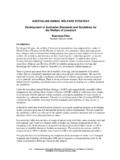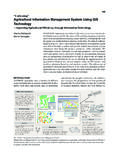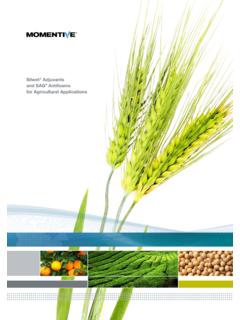Transcription of Getting the Best from your Jambar F1 - Monsanto Africa
1 In this IssueVolume 41 October - December Hybrid Carrot Carina, Word from Management STAK Congress and A Red Revolution in Uganda DK8031 in Muranga Watermelon Hybrid Sentinel in Wambugu ATC Field day Pictorial & Tomato Sauce Excessive Heat and Poor Ventilation in Meet Ronak in Bungoma OBy Daniel MusyokaGetting the best from your Jambar F124 C / 57 Y50 C / 100 Y59 C / 100 Y / 7K68C / 100Y / 24K95C / 100Y / 27K100C / 61Y / 61 KContinued on pg. 3 ..nion is a key vegetable crop in the region, being one of the most widely consumed vegetables it both very marketable and profitable.
2 In East Africa onions are successfully grown on both large and small scale farms. As with any crop, proper management of the crop from seeding to harvest is essential for farming sucess. We share some of these crop management tips with you. Try them out as you grow our short-day red onion Jambar F1!Climatic RequirementsOnions can be grown in a wide range of climatic conditions, they are quite hardy and can tolerate temperatures as low as -6 C. However, good bulb formation requires temperatures from C with an optimum temperature range of 21-27 C, coupled with the correct day- length.
3 Short day onions such as Jambar F1 have - hours day-length threshold for bulb and humidity are important factors during the seedling stage, bulbing and harvesting. Cool wet conditions at the seedling stage result in increased fungal diseases. Soil RequirementsOnions do best in well-drained soils that are at least 650 mm deep, shallow soil may be utilized, but with adaptations in management practices. Ensure a pH range of - ; lower pH levels can result in problems with regard micronutrient onions can be produced on a wide range of soil types, avoid heavy soils as these may lead to problems such as bad aeration, crusting and a blemished product of lower PreparationOn well drained soils, prepare a fine and even seedbed.
4 It is advisable to use seeding trays to ensure that little or no seed is lost during this process. Commercial plant raisers can help farmers raise healthy seedlings for applications should be determined by a soil analysis. Most onion roots are in a 15cm radius from the stem and therefore are shallow feeders. If the soil pH is less than 6 or the available calcium is less than 2300kg per hectare, apply and incorporate agricultural lime at the rate of 2500kg per hectare about 8-12 weeks prior to planting. Lime requires time to react with acid soils to raise the pH. In soils low in phosphorus apply and incorporate approximately 94kg of phosphate per hectare.
5 Generally, it is suggested that the phosphate be banded 6 - below and on both sides of the rows where onions will be planted. Nitrogen applications are critical in terms of quantity and timing of application. The amount of nitrogen supplied depends on the soil analysis. Poor soils may require up to 180kg/hectare for direct sown crops. Average soils would need lower levels - 120-140kg/hectare. Soils low in potassium require an application of 100kg/hectare before planting. The remaining potassium can be applied with the first nitrogen application at a rate of 85kg/hectare. (Three weeks after transplant or when seedling has reached 3-leaf stage.)
6 In applying pre-plant fertilizers it is best to band 6 to 8cm below the seed or transplant, rather than broadcasting and SeedlingsSeedlings are usually ready 8 to 10 weeks after seeding, when the majority of the seedlings necks are pencil-size (65-80mm) in diameter, tall and have 4 to 5 leaves. If irrigating, ensure systems ready, so that irrigation can commence immediately after transplanting to prevent losses of the plant Spacing: 20-30cm between rows x 8cm within the row Approximate plant population is 500,000 plants per hectare. IrrigationWhen planting under irrigation:Irrigate soil to field capacity before planting in order to build up from ManagementElizabeth MrandaSPOTLIGHTIn the2 Carrot KarinaBy Jared OndusoFeaturesHeavy yielder - Nantes-type with higher percentage of marketable carrots.
7 Suitable for fresh market and processing Resistance to Alternaria and high tolerance to powdery mildewLarge and vigorous foliage with strong root attachment Excellent core and external colour with minimal green maturing, harvestable in 85-125 days from sowing. The root shape is very uniform, near cylindrical with an average length of 18-22 cmExceptional orange colour and flavour. Excellent tolerance to breakage and cracking. BenefitsHigher returns as it is a higher yielder - 22-25t/acre Wider market as the variety suitable for both processing and fresh marketsReduced cost of production with less fungicide as the variety has higher disease toleranceReady market as it has quality, therefor higher demand in the marketLess farm wastage as roots are market-quality, there s also reduced breakages and crackingCombines best features of Nantes, Imperator and Kuroda carrots to produce great length, shape, colour.
8 Sweet taste and high beta bountiful harvest enjoyed by our farmers endorses the benefits of growing hybrids in these uncertain times, when climate change and market fluctuations make it challenging for the farmer to plan his/her production cycles. As always, we at Monsanto have continued to walk the journey with farmers; in the past year we brought varieties that yield better and are more resistant to diseases, thus reducing the risks of farming out in the the year ending we have introduced a cross-section of hybrids including Carrot Karina F1, our latest addition, which promises to increase both yield and marketability of the crop.
9 We are setting a benchmark in the market through improvements in the quality of produce and reduction of post-harvest wastage. In line with this, we have in the past year introduced hybrid varieties; Cucumber Darina F1, a high yielding American slicing Cucumber; watermelon Sentinel, a juicy long shelf-life watermelon; Carrot Karina F1, which is high yielding and produces uniform-sized carrots at harvest. Our new hybrids add to Monsanto s growing hybrid portfolio in East Africa , which includes Red Onion Jambar F1; Tomatoes Assila F1, Anna F1 and Eden F1, just to mention a few. These varieties are already contributing to an improved quality of products from our farms.
10 As we start the year we would like to thank all our customers, both farmers and distributors, for the support you have given us so far. We make a commitment to working together at selecting varieties that will improve the standard of farming by bettering production and reducing the uncertainties related to farming in this we work towards curbing the challenges and improving on farming, we take this opportunity to wish you a prosperous year at the Seed Traders Congress ..continued from pg 1 MONSANTO3 Please visit STAK website at to read and view these important topics which will have a great impact in development of seed business in Kenya and the African first ever STAK (Seed Trade Assocaition of Kenya) Congress and Expo took place in Nairobi from the 13th - 15th November, 2012.


![[Incorporating Amendments up to 30 April 2015] - IRD](/cache/preview/0/7/7/c/4/2/f/2/thumb-077c42f2547e408658e6b29ba337704b.jpg)




